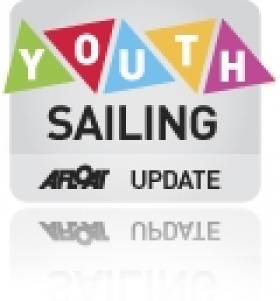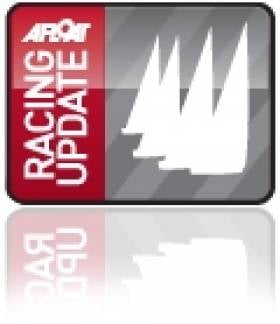Displaying items by tag: Sophie
Murphy Stays in Top Ten at Youth Worlds
In spite of two thirtieth places scored in today's penultimate rounds Irish sailor Sophie Murphy stays in the top ten of the ISAF Youth Worlds in Zadar, Croatia. The Royal St George Yacht Club and Quoile Yacht Club Laser single-hander struggled in day fives stronger breezes, the first of the competiton.
Murphy can stay top ten, an important target, if she has a good final race tomorrow morning.
420 duo Emma Geary from Royal Cork Yacht Club and Niamh Connolly from Baltimore Sailing Club were definitely back on form today having been hampered by yesterday's lighter winds. The girls relished the medium breeze today placing 10th and 6th respectively in their two races. They lie 18th overall.
Philip Doran of Courtown Sailing Club and the National Yacht Club caught up to 12th place during his first race of the day but lost out on the final downwind which saw him finishing in 22nd. He fared better in his second race sitting fifth for the duration until the final mark when he was yellow flagged, the penalty saw him finish ninth leaving him 15th overall.
Meanwhile, Maxime Mazard (FRA) and Giovanni Coccoluto (ITA) go into the final day of racing at the 41st ISAF Youth Sailing World Championship in Zadar, Croatia with just one point separating them in the Laser Radial Boys fleet.
The Frenchman, who has led for the majority of the week, finished 25th and seventh today and has seen his five point overnight lead reduced to a single point after Coccoluto came seventh in Race 10 before discarding his disqualification in Race 11.
The final race tomorrow will decide who takes the gold medal home for their nation and it should be a fascinating finale.
RYA Volvo Team GBR sailor Cameron Douglas shone in the breeze today finishing with a bullet and a second place, he said, “It was an awesome day. We had a bit of breeze for the first time this week so I’m very happy. It has been a really great event.”
Australia’s Matthew Wearn won the days other race but did not finish Race 11 and is down in 26th place and Žan-Luka Zelko is third on 114 points trailing Mazard by eight points.
In the Laser Radial Girls Erika Reineke (USA) also finished with a race win and a second place. The American, who is a full time member of US SAILING’s Team Alphagraphics, said, “I liked today a lot better. There was a little bit of breeze and there was some nice waves. I was pretty far away from the gold today, 19 points, and I think I caught up a bit. I’m just going to go out and try my hardest tomorrow and try to win.”
Tiril Bue regained the lead in the Radial Girls fleet after she was consistent in the breeze finishing third in Race 10 and fourth in Race 11. Overnight leader Paulina Czubachowska came through in 10th and 11th today and has dropped to third overall. Manami Doi (JPN) maintains her second place overall but just two points separate Doi, Czubachowska and Reineke so it should be an interesting climax.
And like the Laser Radial Boys it will be winner takes all between Veronica Fanciulli (ITA) and Siripon Kaewduang-Ngam (THA) with just one point separating the pair in the RS:X Girls. Fanciulli went 2-4 today and Kaewduang-Ngam finished third and recorded a bullet to pull the overnight deficit down to a single point. Naomi Cohen (ISR) is third on 32 points and Agnieszka Bilska (POL), who claimed the days other bullet, is fourth on 36 points.
With three bullets today Louis Giard has leapt into second place in the RS:X Boys on 36 points. But Cho Wonwoo (KOR) continues to lead and will take a six point advantage into the final day following three RS:X races today. The Korean finished 2-4-6 today. Spain’s Mateo Sanz had a minor dent in his scorecard today following a tenth place in Race 9 but bounced back with a third and second. He is third overall on 37 points.
Morgan Kiss and Christina Lewis (USA) closed the gap on 420 leaders Lara Vadlau and Tanja Frank (AUT) to four points ahead of the final day. The Americans finished 4-5 today compared to the Austrians 8-2. Nikole Barnes and Agustina Barbuto (ISV) retain their third place following two seventh place finishes today. Today’s race wins went to Carrie Smith and Ella Clark (AUS) and Maelenn Lamaitre and Aloise Retornaz (FRA).
2010 ISAF Youth Worlds gold medallist Jordi Xammer with new crew Alex Claville regained the lead in the 420 Boys following a tenth and fourth place finish. They lead Japan’s Daichi Mototsu and Yuki Hino by eleven points. Angus Galloway and Alexander Gough (AUS) stay in third place going into the final day and have a two point advantage over Guillaume Pirouelle and Valentin Sipan (AUS)
In the SL16 Brazil’s Martin Lowy and Kim Andrade take a 13 point lead into the final day after they came eighth twice today. And with a fleet of 14, the boys from Brazil will need to sail a steady race tomorrow to seal the deal. Nicolaj Bjornholt Christiansen and Daniel Bjornholt Christiansen (DEN) had a good day coming second and third and are second overall on 37 points. And Great Britain’s Rupert White and Nikola Boniface are third on 48 points.
Carlos Robles and Florian Trittel have an impressive 19 point lead ahead of the final day after a bullet and a sixth place finish in the 29er. The Spaniards have only finished out of the top six twice and with a string of consistent results it would be hard to bet against the Spaniards claiming gold. The race for second place is interesting with Max Deckers and Annette Duetz (NED) on 51 points, Antoine Screve and Max Agnese (USA) on 53 points and Josh Franklin and Lewis Brake (AUS) on 56 points. The days other race win went the way of France’s Gael Jaffrezic and Julien Bloyet who are down in eighth place.
One race in each fleet will take place tomorrow to decide the medals and racing begins at 12:00 local time.
Laser Radial Girl Sophie Murphy is closest to Ireland's goal of sailing to a top ten result at this week's ISAF Youth Worlds in Croatia where conditions at the halfway stage continue to be light and tricky.
The event has added interest for Ireland as it will be staged next year on Dublin Bay, a venue alos know for its flukey winds. The Dublin organiser of the event Brian Craig is in Croatia to monitor progress there.
Murphy scored well in her first of the race of day three with a fourth after having a race win yesterday. She followed that with a 16th and 20th in the 41–strong fleet which leaves her in eleventh position overall going in to the rest day tomorrow.
Cork duo Emma Geary and Niamh Connolly in the 420 finished 17th and 21st today which sees them lying 17th overall.
Philip Doran from Courtown SC in the Laser Radial boys had a disappointing day fininshing 26th overall in the 49 boat fleet. Philip who is no stranger to large international competition (former 4.7 World Champion and the u17 Radial World Champion) remains optimistic and looking forward to a rest day tomorrow before the second half of the event recommences on Wednesday.
Racing Round up: Dun Laoghaire Regatta, ISAF Youths, Optimists, Paralympic, RORC, WIORA, Quarter Ton, Kiteboarding.
In offshore news, the Transatlantic Race 2011 Nears a Finish, and RORC yachts that headed West did best in the St Malo from Cowes race. Ireland's entry in the Tall Ships race, Celtic Mist, is safely in Scotland. WIORA starts this week in Clifden, thirty boats are expected.
Two top Cork performers are in Cowes for this week's Quarter Ton Cup.
In other boating news, rower Siobhan McCrohan won bronze at the World Rowing Champs in Lucerne, Kiteboarding debuted in Dun Laoghaire. There were Medals for Irish Kayakers at Athens Special Olympics.
And finally after a Elaine 'Shooter' Alexander is set for hero's welcome this week as she becomes the first woman from Northern Ireland to circumnavigate the island of Ireland.
All on our home page this morning, thanks for your interest in Irish Sailing and Boating.































































